Blogging Sax Rohmer’s The Shadow of Fu Manchu, Part One
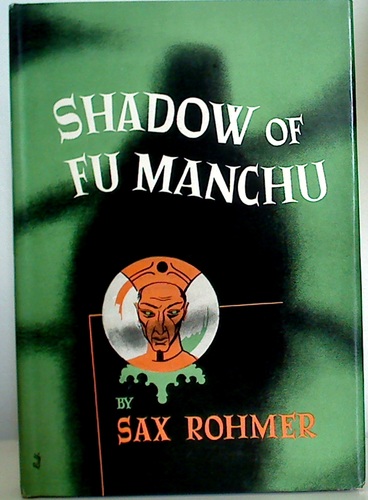
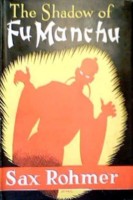 The Shadow of Fu Manchu was serialized in Collier’s from May 8 to June 12, 1948. Hardcover editions followed later that year from Doubleday in the U.S. and Herbert Jenkins in the U.K. The book was Sax Rohmer’s eleventh Fu Manchu thriller and was also the last of the perennial series to make the New York Times bestseller list.
The Shadow of Fu Manchu was serialized in Collier’s from May 8 to June 12, 1948. Hardcover editions followed later that year from Doubleday in the U.S. and Herbert Jenkins in the U.K. The book was Sax Rohmer’s eleventh Fu Manchu thriller and was also the last of the perennial series to make the New York Times bestseller list.
The story had its origins in a Fu Manchu stage play that Rohmer had developed for actor Basil Rathbone. The project had failed to get off the ground, but became instead the first new Fu Manchu novel in seven years. Sadly, during these seven years, the property had begun to fade from the public eye.
It had been eight years since the character last appeared on the big screen (in the popular 1940 Republic serial, Drums of Fu Manchu) and eight years since the well-received Shadow of Fu Manchu radio series (from which the planned stage play and later novel borrowed its title) had left the air. Detective Comics had long since finished reprinting the Fu Manchu newspaper comic strip as a back-up feature for Batman. As far as the public was concerned, Fu Manchu was a part of the past that seemed far removed from the world that had been transformed by the Second World War.
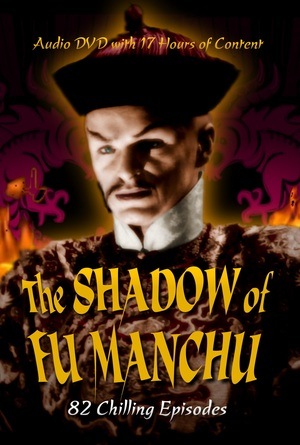
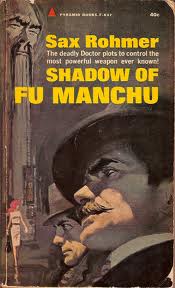 The initial three novels in the series were written before and during the First World War, but were set in a pre-war Britain, where the paranoid delusions of the Yellow Peril personified offered a much needed dose of escapism from the realities of war in Europe. The Yellow Peril itself was a stereotype based on a turn-of-the-century conflict that became an early example of the “foreign-other” bogeymen who would increasingly feed the fears of the West in this new century.
The initial three novels in the series were written before and during the First World War, but were set in a pre-war Britain, where the paranoid delusions of the Yellow Peril personified offered a much needed dose of escapism from the realities of war in Europe. The Yellow Peril itself was a stereotype based on a turn-of-the-century conflict that became an early example of the “foreign-other” bogeymen who would increasingly feed the fears of the West in this new century.
By the time Rohmer revived the series in 1930 (due to the successful exploitation of the character in film and newspaper comic strip form), he altered the formula to not only allow his characters to age in real time, but to have them function in the same world in which his readers were living. For the next decade, Rohmer turned out seven bestselling sequels that took his readers and his characters through the Great Depression and up to the brink of the United States’ entry into the Second World War.
Fu Manchu had dominated the media for thirty years and yet the post-war world found the character rapidly losing relevance. Rohmer commented in interviews of the period that many people were surprised to learn he was still alive. Ageism was not yet a concern for writers in 1948, but Rohmer and his work were identified with the more innocent world that had entered the conflict and not the wiser, but world-weary one that survived in its wake.
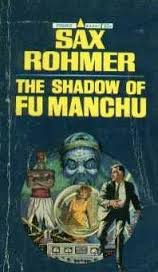
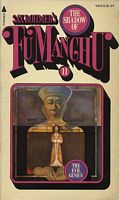 The postwar world would soon embrace the Cold War spy thriller as the paranoid delusion of escapism favored by the masses. Rohmer was a tremendous influence upon such pulp-derived works and did his best to keep up with the times, but somehow the results were unconvincing. Readers still bought the new novel (Readers Digest even published an abridged edition), but the consensus was that Fu Manchu’s return was creaky rather than welcome and ensured the character began its great eclipse into obscurity after this point.
The postwar world would soon embrace the Cold War spy thriller as the paranoid delusion of escapism favored by the masses. Rohmer was a tremendous influence upon such pulp-derived works and did his best to keep up with the times, but somehow the results were unconvincing. Readers still bought the new novel (Readers Digest even published an abridged edition), but the consensus was that Fu Manchu’s return was creaky rather than welcome and ensured the character began its great eclipse into obscurity after this point.
The problem appears to have been two-fold. First, Rohmer had now reached retirement age and time was rapidly catching up with him. The story gets away from him at times and there is precious little suspense when, for example, the author introduces the mysterious character of a concentration camp survivor turned prominent psychiatrist, only to reveal in the next paragraph that it is actually Fu Manchu in disguise.
A preoccupation with aging (one character complains that their physician wants them to cut back on smoking and red meat) and a surprising injection of autobiographical references (Rohmer’s womanizing had seriously damaged his marriage at the time and so we find Fu Manchu musing that, like the straying husband, he is misunderstood by the world despite his good intentions in a bit of dialogue that would otherwise appear ridiculous) point to the book being a late-period work and the result of the author’s inevitable creative decline with advancing age.
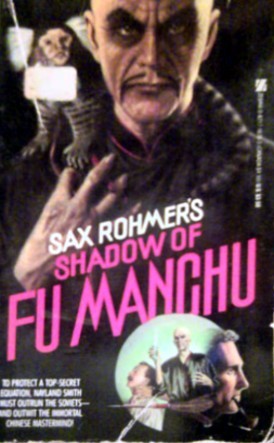
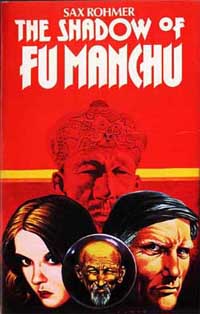 The second problem is the theatrical origins of the story. Despite a genuine attempt to rewrite the play as a novel, there is far too much comic relief (understandable considering Rohmer’s concept of theater was already dated, but it makes for an incongruous note as part of the literary series), an annoying reliance on American slang, and so many rapid entrances and exits from scenes that one fears the thriller is turning into a farce. While Rohmer retains Nayland Smith’s staccato speech, he has several other characters appear to imitate his delivery. The result is both tiresome and unconvincing.
The second problem is the theatrical origins of the story. Despite a genuine attempt to rewrite the play as a novel, there is far too much comic relief (understandable considering Rohmer’s concept of theater was already dated, but it makes for an incongruous note as part of the literary series), an annoying reliance on American slang, and so many rapid entrances and exits from scenes that one fears the thriller is turning into a farce. While Rohmer retains Nayland Smith’s staccato speech, he has several other characters appear to imitate his delivery. The result is both tiresome and unconvincing.
The plot is straightforward enough. Dr. Morris Craig has invented a device that has the potential to serve as a force field and protect whole cities from atomic attack. His invention makes him the target of multiple governments (even friendly ones) who converge on the Manhattan think-tank where he is employed in an effort to steal the device for their own country’s advantage. Ridiculously, Craig’s only protection comes in the form of an aging Sir Denis Nayland Smith paired with the criminally under-utilized FBI Agent Raymond Harkness (who will return in the next entry in the series).
Dr. Fu Manchu has a new chief of staff in the form of Huan Tsung Chao (another character slated to return in the Fu Manchu stories of the 1950s). The character is a reworking of John Ki, formerly known as Sam Pak, who filled the same position and shared many of the same traits and background as Huan Tsung Chao in earlier books.
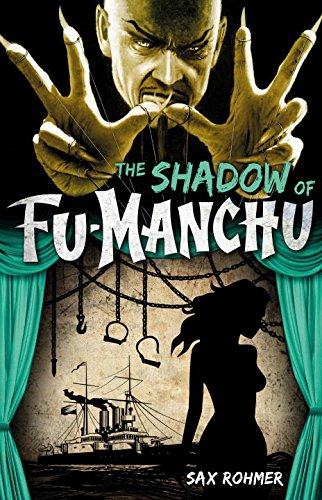 The novel is strangely lacking in the continuity references readers had come to expect. This is a result of it being rewritten from a stage adaptation based on the long-running series of books rather than a direct continuation of the same. Consequently, instead of a reference to Dr. Sven Ericksen and the Ericksen Ray (a regular staple of the series since The Golden Scorpion in 1918), we have Dr. Sven Helson and the Helson Lamp. It’s a bit like trying to reconcile a James Bond novelization with the literary series. There are as many differences as similarities and the result can never prove satisfactory.
The novel is strangely lacking in the continuity references readers had come to expect. This is a result of it being rewritten from a stage adaptation based on the long-running series of books rather than a direct continuation of the same. Consequently, instead of a reference to Dr. Sven Ericksen and the Ericksen Ray (a regular staple of the series since The Golden Scorpion in 1918), we have Dr. Sven Helson and the Helson Lamp. It’s a bit like trying to reconcile a James Bond novelization with the literary series. There are as many differences as similarities and the result can never prove satisfactory.
Fu Manchu seems strangely out of place in a Cold War setting. Rohmer and his most famous creation had overstayed their welcome. A return to the more offensive racist stereotypes of Chinese characters speaking Pidgin English only adds to the sense that the series and its author were out of touch. Once again, this was an (albeit, badly dated) theatrical touch that Rohmer would likely have avoided had the story been developed as a novel from the outset. Part Two of this article will examine the plot of the book in greater detail.
William Patrick Maynard was authorized to continue Sax Rohmer’s Fu Manchu thrillers beginning with The Terror of Fu Manchu (2009; Black Coat Press) and The Destiny of Fu Manchu (2012; Black Coat Press). The Triumph of Fu Manchu is coming soon from Black Coat Press.